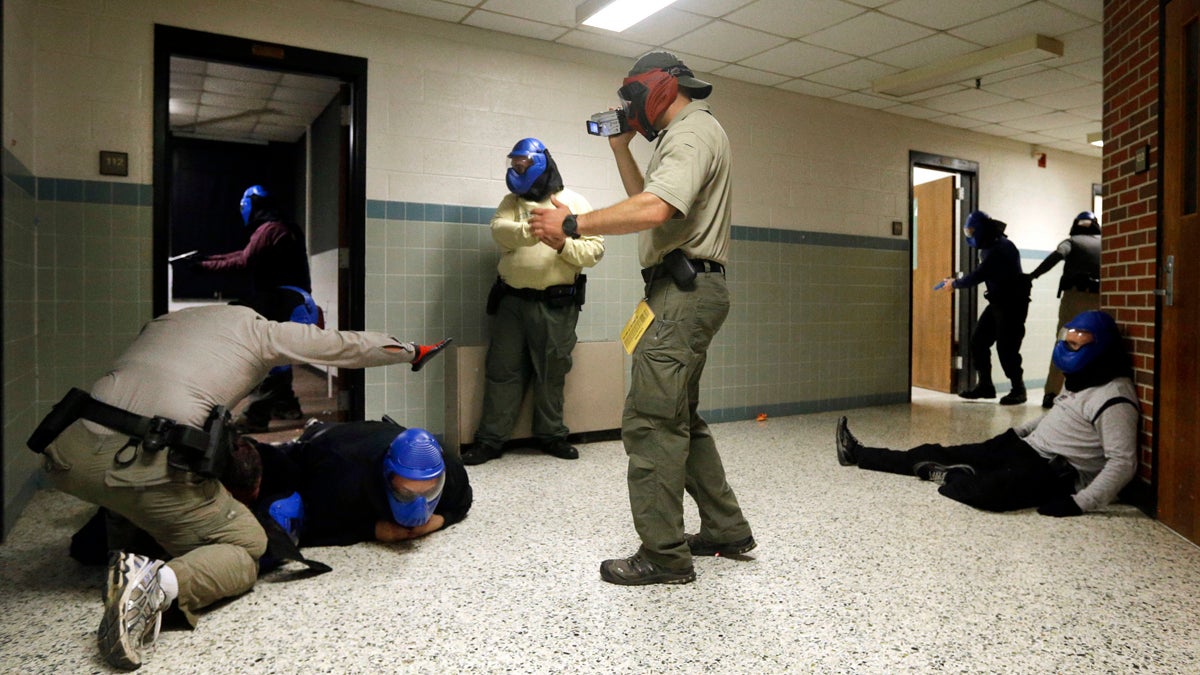Preparing for the unimaginable — and its aftermath

FBI instructor Mike Sotka, center, films police officers in 2013 as they participate in an active shooter drill in a college classroom building in Salisbury, Maryland, as part of an FBI program that teaches local law enforcement best practices for responding to mass shootings. (Patrick Semansky/AP Photo)
As we learn more about the mass shooting at a state-run facility in San Bernardino California, medical centers in our region say they are prepared for the unexpected.
When there’s a gunman nearby, safety experts term it an ”active shooter situation.”
There are three recommended options: Run, hide, or fight.
If possible, fleeing the scene is the first, best choice, said Wesley Light, who manages emergency preparedness at Temple University Hospital.
“If you can’t get out of the immediate area of the shooter, the best thing is to hide. Shelter yourself in a closet that’s quiet, dark, to get out of the path of a shooter,” Light said.
Cathleen Bennett, acting health commissioner in New Jersey, said medical centers have special challenges as administrators prepare. Emergency departments, in particular, face higher risks.
“That seems to be a location where emotions run high and behavior can be unpredictable,” she said. “Hospitals have infectious diseases in them, they have equipment like MRI, with large magnets, which can impact what’s going on if you have an active shooter situation.”
New Jersey has a law — the Violence in Health Care Facilities Act of 2008 — requiring hospitals to create a violence prevention program.
Medical centers — whether large or small, urban or suburban — prepare the same way, because you can’t predict where the next incident will happen, said Mark Ross, the southeastern Pennsylvania emergency preparedness manager with the Hospital and HealthSystem Association of Pennsylvania.
Different from a shopping mall or school, Bennett said, hospital planning is especially important because medical centers must protect vulnerable patient populations including those in intensive care.
Ross said in a “no-notice” mass casualty event — such as the Amtrak train derailment in Philadelphia — a hospital is sometimes locked down to make sure health workers have the space to care for patients without being overwhelmed by media or the curious.
A lockdown is also a way to protect the staffers from becoming secondary targets. In attacks overseas, Ross said, terrorists have tried to do more damage after an initial attack
In Southeast Pennsylvania, a coalition of organizations plans together. Emergency planners had more time to get ready for Hurricane Irene and the papal visit, and those kinds of events serve as “practice” for higher stakes incidents.
Alan Butler directs health care security operations for HSS, a company that provides security services and planning help to health care facilities in several states.
He urges his clients to train for the unexpected. But every not department of a medical center has the same needs. The level of preparation — and the frequency of drills — may be different for emergency room staffers compared with workers in other parts of a medical facility.
WHYY is your source for fact-based, in-depth journalism and information. As a nonprofit organization, we rely on financial support from readers like you. Please give today.

